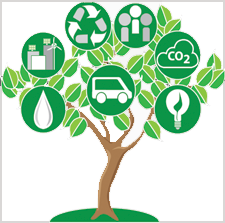Sustainable Packaging Saves the Planet
April 22, 2019
Today is Earth Day which gives us the perfect opportunity to talk about sustainability and sustainable packaging. In order to preserve our Earth, we need to ask what we can do to be sustainable. When considering your packaging the two biggest components for sustainability are minimizing carbon footprints and recycling materials.
Lowering Carbon Footprint
Reducing CO2 emissions can be a win-win for you and the environment. Down-gauging, reducing the thickness of the material, it is a great option because it can be used with many different label types. Reducing the thickness means fewer materials are being used, which saves on cost. Down-gauging can also lower CO2 emissions because more material can fit on one roll, which means fewer shipments need to go out. Before making any drastic changes to your package, it is important to know your label application machinery, because some cannot handle thinner materials. Thinner substrates mean less adhesive is needed to place the label on the packaging. When keeping adhesives at a minimum it makes the overall product lighter which prevents more CO2 from going into the air. Glue applied labels, like cut and stack, are the perfect example of this.
Due to the lightweight nature of flexible packaging, you can have these same benefits, but there are some challenges to flexible packaging. It is made up of layers of different materials, which causes challenges in recyclability. However, there is development to counteract the complexity of flexible packaging. However, choosing flexible packaging allows you to shrink your carbon footprint significantly. Did you know that using a rigid container instead of a pouch for laundry pods emits 726% more greenhouse gases? Even making the switch from glass jars to flex pack can save over 20 truckloads of shipments. Flexible packaging can also save water, fossil fuels, and landfill waste. Flexible packaging is thinner and lighter than traditional materials, meaning less material gets sent to landfills.
Inks can offer many CO2 reducing options as well. Choosing water-based inks for gravure printing and plant-based inks for offset printing are great for reducing VOCs (volatile organic compounds) by up to 80%. Plant-based is made from 60% of renewable content. Also, there’s no need to worry about running any additional machinery like you would with solvent-based inks. Lowering the VOCs being emitting decreases the number of greenhouse gas emissions, smog, and CO2 in the atmosphere.
Recyclable Materials
Over the last 25 years, the annual recycling rate has doubled. This is a big step in the right direction and we can continue this trend by making products recyclable. One of the biggest obstacles can be having a package and a label that is made of different materials. Until they are separated they cannot be recycled. Blow mold and in-mold labels are a great example of packaging that is made of like materials and are recyclable. For these packaging types, the label becomes part of the container during the molding process. In order to get the label to adhere to the package, they need to be made of the same materials.
Earlier we talked about down-gauging and all the benefits it has. Another is the labels are easier to separate from the packing because they require less adhesive. Pressure Sensitive labels offer two opportunities to be downgauged; both the face stock and liner can be thinned. Utilizing specialized label substrates, they can be cleaned or ‘flake’ off during the process of cleaning recycled material. You could also choose to have a substrate made from recycled materials.
While this may cost more, it is a great way to lower the environmental impact. In the future, there will be more options for sustainable packaging because big brands are making commitments to be environmentally friendly. Nestlé is among these brands, aiming to be more sustainable by 2020.
One of the key aspects of recycling is the correct sorting of material. When products have a full body shrink sleeve it can prevent correct sorting. However, there are a few ways to increase the chances of correct sorting. You could down-gauge the label because most modern sorting systems can see through it. Even having 20% of the package exposed or an unprinted area can boost the chances. Some companies are offering solutions that allow the shrink sleeves to come off during the bottle wash process like; sleeves that deseam, an adhesive/sleeve combination, and floatable shrink materials.
Inland has many initiatives to increase our efforts in sustainability beyond just sustainable packaging materials that we use for your packaging. Our offices utilize video conferencing, motion sensor lights, and have a recycling program. We cut down energy consumption by re-using the heat from our presses during the cold winter months. If you want to chat sustainability click the LiveChat icon on the sidebar or click here.



